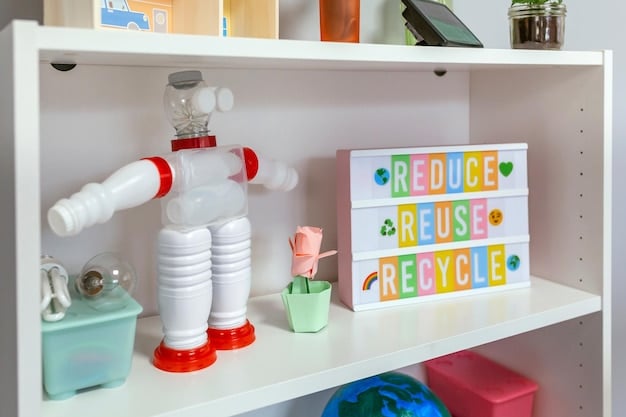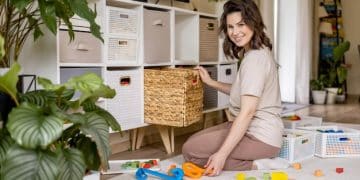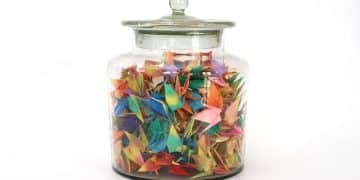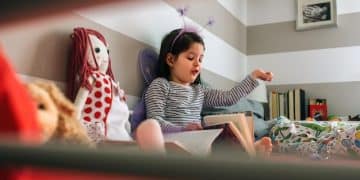Maximize Playtime: Toy Rotation for Renewed Engagement

Maximize Playtime: Rotate Toys Every 2 Weeks for Renewed Engagement involves a strategic system of exchanging toys available to children, usually every two weeks, to sustain their interest and promote ongoing learning and creativity.
Are you looking for a simple yet effective way to keep your little ones engaged and excited about their toys? The secret might just lie in toy rotation. By implementing a system to maximize playtime: rotate toys every 2 weeks for renewed engagement, you can transform playtime from a routine to an adventure, fostering creativity and learning along the way.
What is Toy Rotation and Why Does It Matter?
Toy rotation is a method of organizing and managing a child’s toys by making only a select few available at any given time, while the rest are stored away. Periodically, these toys are swapped out, or rotated, with the stored toys. This approach isn’t just about decluttering; it’s about enhancing the quality of playtime.
But why does toy rotation matter so much? Let’s delve into the reasons.
Reduced Overstimulation
Children surrounded by too many toys can easily become overwhelmed. Toy rotation helps reduce this overstimulation.
Renewed Interest
When toys reappear after a break, they feel new and exciting again.
- Increased Focus: Fewer distractions lead to longer and more focused play sessions.
- Creative Exploration: Children explore toys in new ways when they rediscover them.
- Improved Learning: Reintroducing toys reinforces learned skills and encourages further development.
Toy rotation is a simple strategy that provides immense benefits, fostering a more engaging and enriching play environment for children.
Benefits of Rotating Toys for Enhanced Development
Rotating toys offers advantages that stretch far beyond simply tidying up a playroom. The practice has profound effects on a child’s development, influencing their cognitive abilities, creativity, and more. By limiting the number of toys available at any one time, and strategically rotating them, parents can create an environment that fosters deeper engagement and learning.
Let’s explore the benefits of rotating toys for enhanced development.

Toy rotation cultivates increased focus and attention span. When children are faced with a multitude of toys, they often flit from one to another, never fully engaging with any single item. By reducing the number of options, toy rotation encourages children to spend more time with each toy and truly explore its possibilities. This focused engagement not only enhances their concentration skills but also leads to a deeper understanding of the toy’s function and potential.
Furthermore, toy rotation encourages creativity and imagination. When children rediscover toys that have been out of sight for a while, they often approach them with fresh eyes. They might invent new games, discover alternative uses, or combine the toy with other items to create something entirely new. This process of creative discovery is crucial for developing problem-solving skills and fostering innovative thinking.
Finally, toy rotation also aids in skill reinforcement and learning. By periodically reintroducing toys that promote specific skills, such as fine motor skills, language development, or mathematical concepts, parents can reinforce these skills in a playful and engaging way. This approach makes learning fun and helps children retain information more effectively.
In essence, toy rotation is a powerful tool for promoting holistic child development. It enhances focus, fosters creativity, and reinforces learning, ultimately contributing to a more enriching and stimulating play environment.
Step-by-Step Guide to Implementing a Toy Rotation System
Implementing a toy rotation system may seem daunting at first, but with a little planning and organization, it can become a simple and effective way to enhance your child’s playtime. The key is to approach the process systematically, ensuring that it aligns with your child’s developmental needs and interests. Here’s a step-by-step guide to get you started.
The initial preparatory steps involve evaluating and categorizing your child’s toys.
Evaluate and Categorize Toys
Begin by taking stock of all your child’s toys. Sort them into categories based on type, skill, or developmental stage.
Choose Rotation Frequency
Decide how often you want to rotate the toys. A bi-weekly rotation is a good starting point.

- Create a Schedule: Develop a simple schedule or calendar to track when toys need to be rotated.
- Prepare Storage: Allocate storage space for the toys that are not currently in use.
- Engage Your Child: Involve your child in the rotation process by asking for their input.
Implementing a toy rotation system step-by-step ensures a smooth transition, enabling you to enjoy the benefits of enhanced play and development for your child.
Tips for Maximizing the Benefits of Toy Rotation
While implementing a toy rotation system is a good start, to really maximize its benefits, there are a few extra tips and strategies you can incorporate into your routine. These best practices ensure that you use the toy rotation system effectively. They also help you create a dynamic and engaging play environment aligned with your child’s developmental needs.
Making the most of the toy rotation system involves a number of strategies.
Embrace variety in order to stimulate their minds in different ways. Include toys that cater to fine motor skills, gross motor skills, problem-solving, and creative expression. This exposure to diverse skill sets supports holistic development.
Think of thematic rotations by arranging toys based on a specific theme. For example, one rotation could focus on transportation, featuring toy cars, trains, and airplanes. Another could be centered around animals, with plush toys, animal figurines, and books about wildlife. Thematic rotations can make playtime more engaging and educational.
You should continuously observe your child’s play habits and preferences. Notice which toys they gravitate towards, which ones hold their attention the longest, and which ones seem to spark the most creativity. Use this information to tailor your toy rotations to match their interests and developmental stages. Replace or update toys that no longer engage your child or that are not age-appropriate.
By implementing these tips, you not only keep your child engaged and entertained but also foster their development in a fun, creative, and personalized manner.
Addressing Challenges and Common Mistakes
Even with the best intentions, implementing a toy rotation system can come with its set of challenges. Parents may encounter resistance from their children or struggle to maintain the system consistently. Understanding these challenges and knowing how to address them is key to ensuring the long-term success of toy rotation.
A common challenge is dealing with separation anxiety when removing toys. Children may become attached to certain toys and resist putting them away, even temporarily.
Strategies for Minimizing Resistance
Preparation is key to minimizing resistance from children when introducing toy rotation.
Another issue is maintaining consistency. Life with young children can be chaotic, and it’s easy for toy rotation to fall by the wayside amidst other responsibilities.
- Establish a Routine: Set aside a specific time each week or month to rotate toys.
- Involve Other Caregivers: Ensure that all caregivers, including grandparents, nannies, or daycare providers, are onboard with the toy rotation system.
- Be Flexible: While consistency is important, be flexible enough to adapt the rotation schedule to accommodate vacations, illnesses, or other disruptions.
By proactively addressing these challenges and avoiding common mistakes, parents can create a smooth and effective toy rotation system that enhances their child’s playtime and fosters their overall development.
Creative Toy Rotation Ideas for Different Age Groups
Toy rotation isn’t a one-size-fits-all solution. What works for a toddler may not be as effective for a preschooler or an older child. Tailoring your toy rotation ideas to suit different age groups is essential for maximizing engagement and developmental benefits. By understanding the evolving needs and interests of children at various stages, you can create toy rotations that are stimulating, challenging, and enjoyable.
When creating age-appropriate toy rotation plans, start with infants.
Keep activities simple and focus on toys that stimulate their senses. Provide soft, textured toys for tactile exploration. Also, offer contrasting black-and-white toys for visual stimulation, and musical toys for auditory exploration. Rotate these sensory toys regularly to keep them engaged and support sensory development. Introduce toys that promote motor skill development, such as rattles, stacking cups, and soft blocks, as they gain more control of their bodies.
For toddlers, concentrate on cause-and-effect toys. Toys that provide chances for problem solving and early learning should be present. Offer toys that encourage dramatic play, such as dress-up clothes, toy kitchen sets, and dollhouses, as well as toys that promote language. These encourage them to pretend and create.
Finally, for school-aged children, provide advanced crafts, puzzles and board games. Also, think about offering toys that allow them to express their creativity.
Customizing play allows children to get the most out of playtime and grow in a fulfilling way.
| Key Point | Brief Description |
|---|---|
| 🔄 Renew Toy Interest | Rotating toys keeps them interesting & engaging. |
| 🧠 Boost Cognitive Skills | Encourages focus, creativity & problem-solving. |
| 🗓️ Schedule Rotation | Rotate toys bi-weekly for ideal engagement. |
| 🧸 Age-Appropriate Selection | Select toys based on your child’s developmental needs. |
Frequently Asked Questions
▼
A bi-weekly rotation is a great starting point, but you can adjust based on your child’s interest levels. If you notice your child is losing interest sooner, try rotating toys more frequently, like weekly.
▼
Focus on selecting a variety of toys that promote different skills and cater to your child’s interests. Include toys that encourage creativity, problem-solving, motor skills, and language development.
▼
Use clear storage bins or containers to keep the toys organized and easily accessible. Label the bins with the contents to make it easier to find specific toys when it’s time to rotate.
▼
Yes, involving your child can make the process more engaging. Ask for their input when selecting toys for rotation and involve them in packing away the toys that are being stored. It can teach them about organization.
▼
Acknowledge their feelings and validate their attachment to the toy. Offer a compromise, such as allowing them to keep the toy for a limited time or promising to bring it back in the next rotation.
Conclusion
By implementing a strategic system to maximize playtime: rotate toys every 2 weeks for renewed engagement, you can transform playtime from a routine to an adventure, fostering creativity and learning along the way. The system enhances a child’s engagement and skill development, making playtime a source of endless possibilities.





